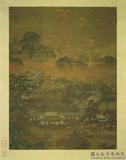宋四家墨寶 冊 宋黃庭堅書尺牘
推薦分享
資源連結
連結到原始資料 (您即將開啟新視窗離開本站)後設資料
- 資料識別:
- 故書000235N000000010
- 資料類型:
- 類型:書法
- 型式:文字
- 著作者:
- 黃庭堅
- 出版者:
- 數位化執行單位:國立故宮博物院
- 格式:
- 本幅 28.9x37.6公分、全幅 43.5x77.7公分
- 語言:
- 漢文
- 關聯:
- 石渠寶笈續編(養心殿),第二冊,頁1097 &*故宮書畫錄(第三卷),第一冊,頁141 &* 黃庭堅(西元一0四五-一一0五年),字魯直,亦號涪翁。和蘇軾、米芾、蔡襄同為北宋四大書家。 此作又稱〈糟薑銀杏帖〉,為黃庭堅收到朋友托贈糟薑、銀杏後,回贈雍酥、青州棗時所寫的便箋。全幅尺牘以圓筆藏鋒書之,勁健婉通,頓挫有力,雖不見其書風中字勢欹側、橫劃斜向伸出的特徵,卻也別具風韻。此帖有千字文第八一四「厭」字編號。 &*故宮歷代法書全集,第十一冊,頁4-37、186-193&* Huang Tingjian (style name Luzhi, sobriquet Shangu daoren) was native to Fenning, Jiangxi, and (with Su Shi, Mi Fu, and Cai Xiang) one of the Four Song Masters. Huang wrote this note after receiving from a friend a gift of zao ginger and gingko, sending in return yong pastry and Qingzhou dates. Also known as “Ginger and Gingko,” the note was done with rounded brushwork using a centered tip, being strong yet elegant. The starts and stops to the brush are powerful, too. Though the characters lack the powerful, slanted style often seen in his calligraphy, the strokes still extend in his characteristic manner and with individual grace. This work bears the 814th character from the “Thousand Character Classic” (yan 厭), one of Xiang Yuanbian’s accession numbers.
- 管理權:
- 國立故宮博物院
授權聯絡窗口
- 國立故宮博物院圖像授權、出版授權、影音資料授權-申請流程說明
http://www.npm.gov.tw/zh-TW/Article.aspx?sNo=03003061






